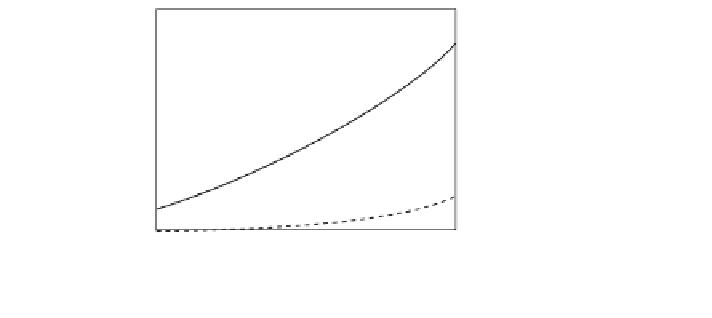Environmental Engineering Reference
In-Depth Information
Table 7.1
Middle air resistance value for a surface of A = 2m
2
h
-1
) (mi hr
-1
)
Car design
C
R
value at the speed (km
40.0
(24.8)
80.0
(49.7)
120.0
(74.6)
180.0
(111.9)
Optimal streamlined car
0.15-0.20
0.29
2.3
8
18
Car with chassis covered
a
0.22-0.25
0.37
3.0
10
24
Estate car, station wagon
0.30-0.34
0.52
4.1
14
33
Off-road vehicle
0.35-0.50
0.71
5.5
19
44
Motor bike
0.60-0.70
-
-
-
-
Buse
0.60-0.70
-
-
-
-
Heavy duty vehicle
0.80-1.50
-
-
-
-
a
Reflectors and spare wheels in the trunk
10.0
Opening headlight
Panorama mirrors
7.5
5.0
Conventionally running
tyres
2.5
Smooth running tires
0
40
60
80
100
120
-1
velocity [km*h ]
Fig. 7.1
Consequences of technical changes in a mid-size car on fuel consumption
Opening headlights or the use of panorama outside mirrors increase resistance,
however, these measures service the safety. In passenger car, the air resistance
increases with the use of additional equipment; such as roof boxes, ski racks, roof
racks, opened front and side windows [
2
].
Changing the aerodynamic form has clear limits. For example, if the con-
struction of the front windshield has a too flat angle to optimize air resistance, the
solar heat increases the temperature inside the car. In this case the driver needs to
use air conditioning, a measure which usually negates all the positive results
obtained through the saving the fuel.
7.1.2 Relation Between Speed and Fuel Consumption
The power needed to overcome air resistance grows with the square of the
velocity. Therefore, slower driving to reduce air resistance is the most important
measure for drivers to lower fuel consumption; see Fig.
7.2
[
3
].
















Search WWH ::

Custom Search